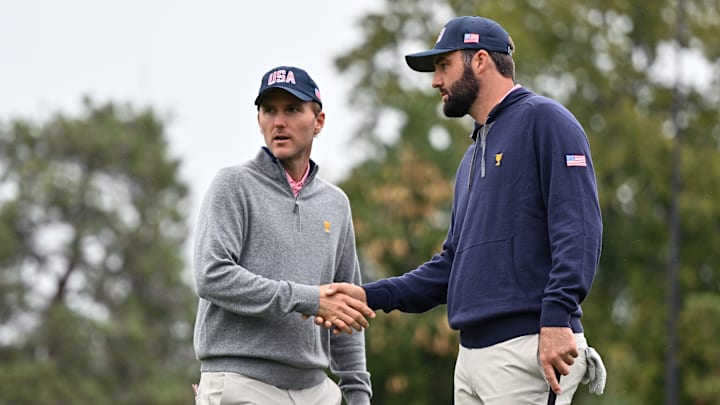Usually in team competitions, when a good partnership develops, you keep it. Like Seve Ballesteros and Jose Maria Olazabal, who made up Europe’s most successful Ryder Cup partnership ever. Or Darren Clarke and Lee Westwood, followed by Nick Faldo and Ian Woosnam. The script was ripped up with Jim Furyk’s first round better ball matches in the Presidents Cup.
He split up Scottie Scheffler and Sam Burns and Patrick Cantlay and Xander Schauffele. If there had been a gallery when these changes were announced, there would likely have been a loud, collective gasp, as though someone had died on stage, followed by much murmuring.
But maybe Furyk and his assistants saw something in the stats that indicated it was the way to go for this group of 12.
“If you've got eight guys or ten guys on the course, we're trying to maximize your potential, get the best five groups you can get out there on the golf course,” U.S. Team captain Jim Furyk said.
So now we have to read his mind, and unfortunately, just as he’s often very forthcoming, Furyk can also be fairly inscrutable. This time, it was definitely the latter. But, of course, we are going to take a whack at it.
It’s important to remember that the Thursday matches are better ball.
Here are the Presidents Cup teams for Round 1:
- Match 1: Xander Schauffele/Tony Finau (U.S.) vs. Jason Day/Byeong Hun An (International)
- Match 2: Collin Morikawa/Sahith Theegala (U.S.) vs. Adam Scott/Min Woo Lee (International)
- Match 3: Scottie Scheffler/Russell Henley (U.S.) vs. Sungjae Im/Tom Kim (International)
- Match 4: Wyndham Clark/Keegan Bradley (U.S.) vs. Taylor Pendrith/Christiaan Bezuidenhout (International)
- Match 5: Patrick Cantlay/Sam Burns (U.S.) vs. Hideki Matsuyama/Corey Conners (International)
By looking at them, it’s clear that Furyk is going to try to win every match on Thursday by making sure he has a top guy in every pairing. He is betting that Schauffele, Morikawa, Scheffler, Clark, and Cantlay can beat one or both of the opposing team that they play against. It’s an interesting strategy, and it just might work for better ball.
In doing this, the U.S. just has to have one score that beats everybody else in that foursome. If the top guy in each foursome falters on a hole, he will have a great backup in a partner with great skill. If you are Patrick Cantlay, how would you like to have Sam Burns as a backup? You’d like his putter, certainly.
So, it’s not about playing every match with your pal, although that’s probably, as Fred Couples used to say, “a blast.” It’s about figuring out how to get a point out of every match on the course and putting people together who are emotionally good together, which was Paul Azinger’s and Fred Couples’ gift to US teams. Zinger needed research to do it; Couples just did it naturally.
Sure, Furyk's plan is not going to work every time, but you have to bet it’s going to work often, and with luck, it might even translate to the Ryder Cup in Europe. An added bonus for Furyk is that many of the U.S. players like and respect each other. Petty jealousies seem to be a thing of the past.
When looking at what seems to be Furyk’s strategy, it’s important to remember they are playing the easiest format on Day 1. That’s better ball. The guy who makes the lowest score of the four players wins the hole. If there’s a tie, then nobody wins it.
Importantly, the scheme won’t work for alternate shot (foursomes) because then golfers are playing every other shot for the whole round. Or some slight modification of that.
However, Paul McGinley offered up a thought on Golf Channel about alternate shot with regard to the Royal Montreal Golf Course. He said that the par 3s are all on odd-numbered holes. That means whoever tees off on No.1 will hit the tee shot on every par 3.
He also said that two par 3s are long and two are short. Then he threw in some additional wisdom adding that the person hitting first on the par 3s needs to be a good putter because on the long par 3s, there might be missed greens.
He could have said that when greens are missed, it’s going to be important for the guy who hits second to have a great short game because then the putts his partner hits will be short ones, not 30-footers.
So, it’s clearly possible to drive yourself crazy with Presidents Cup or Ryder Cup strategies, but this one of having a big-time player in each pairing looks like the kind of thing that Europe did against the U.S. many times when they relied on what was called their Big Five -- Ballesteros, Bernhard Langer, Faldo, Sandy Lyle, and Ian Woosnam. When a lesser player made the team, meaning a player not named Seve, Langer, Faldo, Sandy, or Woosie, one of the Big Five would take the new guy under his wing and often get the point. Paraphrasing what Ballesteros said to Olazabal in the 1987 matches: 'You just play your game, and I’ll do the rest'. The Big Five did quite a lot of that.
With his better ball pairings, it looks like Furyk is taking a page out of the European strategy, and Europe sure proved it could work. If it does, maybe it translates to Ryder Cups, too.
